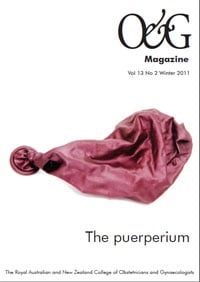‘The puerperium […] is rapidly losing medical interest and importance, perhaps dangerously so, because of our modern preoccupation with antenatal care.’ Sir Ian Donald, Practical Obstetric Problems Fifth Edition 1979
The late and great Scottish obstetrician Sir Ian Donald’s lament is probably not far off the mark even today. ‘Come back and see me when the baby is six weeks old’, is our DRANZCOG usual predischarge request to postnatal mothers. A rather flippant approach compared to our more attentive late pregnancy antenatal care. Puerperium is the Latin word for childbirth, so we use it with licence to mean: the postpartum period from the birth of the baby through to complete involution of the uterus at six weeks.
Our cover image of the deflated balloon is great symbolism, but short-changes this remarkable time in the reproductive woman’s life. Certainly the emptying of the uterus of the baby and, particularly, the placenta trigger physiological changes that should make us ‘ooh and ah’ in the same way we do when watching a Sir David Attenborough documentary, but the process is taken for granted. There is no other natural process, not even a pathological one, where the human body loses an endocrine organ in an instant. It is necessary to propel a woman on a pathway to lactation or a return to fertility. The pregnant state, which has developed over nine months, no longer exists and this new puerperal state affects every part of a woman’s body. For example, the uterus weighs 1kg after birth, but less than 100g by six weeks. The total net water gain in pregnancy of 8.5 litres is steadily lost. The hypercoagulable state normalises slowly. FSH, LH, oestrogen and progesterone levels plummet by factors of between eight and 200 times. These are no mean feats.
All usually goes smoothly, but of course problems do occur frequently and it is the obstetrician’s, and often the GP’s, role to guide women through this time. Problems range from infection, thrombosis and psychiatric concerns to managing breastfeeding and looking after the newborn.
This issue of O&G Magazine ends the journey that started in late 2007, with tales from the first trimester, taking reader through each trimester of pregnancy and then childbirth. It hopes to address some of the issues of the puerperium, but of course is not totally comprehensive. We hope you find this edition interesting and helpful in making the puerperium a less neglected time for our patients.






Leave a Reply